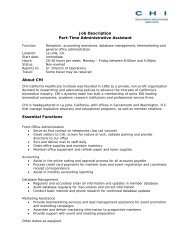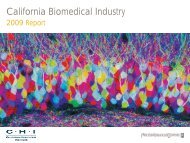California Biomedical Industry - California Healthcare Institute
California Biomedical Industry - California Healthcare Institute
California Biomedical Industry - California Healthcare Institute
Create successful ePaper yourself
Turn your PDF publications into a flip-book with our unique Google optimized e-Paper software.
Legislator profileRepresentative Brian BilbrayIt is heartbreaking to lose a parentto disease. It is devastating to losea child. Representative Brian Bilbrayhas suffered both.“I was in 10th grade when I lost myfather to cancer. I watched what thathideous disease can do not just to myfather, but to the entire family.“But I have to say that it was when Ilost my first son to crib death, SIDS,that I received the biggest wakeupcall about how important research is,”Rep. Bilbray said.These experiences inspired Rep.Bilbray’s longstanding commitmentto helping others avoid such tragediesby supporting federal government’sinvestment in biomedical researchthrough the National <strong>Institute</strong>s ofHealth (NIH). “Some of us have to standup and be willing to take the heat todo the right thing if we want to see themiracles of the future,” he explained.Rep. Bilbray has long held a strongcommitment to fiscal conservatism,which means he usually advocates lessgovernment spending, not more. Butbiomedical research is an exception.The federal government has the scaleand ability and, Rep. Bilbray believes,the constitutional obligation to invest inthe nation’s research foundations. With6 | <strong>California</strong> <strong>Biomedical</strong> <strong>Industry</strong> 2011 Reportan annual budget of more than $31billion, NIH is the cornerstone for thenation’s medical research enterprise.It is from there that private investmentand research institutions may help buildtomorrow’s miracles.The federal commitment must be alsobe consistent over long periods of time.Only sustained investment, says Rep.Bilbray, will allow future generations tolive better. From 1998-2003, Congressdoubled NIH’s budget. But at the endof that period, funding essentiallyflattened. Apart from a one-timeinfusion of Recovery Act funding, it hasremained flat ever since. For this reason,Rep. Bilbray calls the doubling, in whichhe admits his strong involvement, “wellintentioned,” but unsustainable over thelonger-term.Instead, he says, the solution must be acollaborative, non-partisan effort to finda truly long-term, even generationalstrategy, for NIH that will encourage theentire biomedical ecosystem to thrive.“We need to work together, Democrats,Republicans and Independents. Weneed to work as Americans to find thelevel of commitment that the federalgovernment can make so that privateinvestors and researchers can know thatthere is long-term involvement. Andthat in turn allows them to know whatlong-term commitments they need tomake,” said Rep. Bilbray. Additionally,he believes we must reform the federalgovernment to ensure these researchbreakthroughs are translated toinnovative, lifesaving products. Thisincludes reforming the U.S. Food andDrug Administration (FDA) so thatwe can bridge the infamous “valley ofdeath” and translate research frombench to bedside.Those commitments are essentialgoals for the seasoned congressman.There have been great strides in cancertreatment: the overall death rate hassteadily declined since the early 1990sand the five-year survival rate is now68 percent, up from 50 percent in the1970s. And researchers know todaythat cancer is not just one disease, buthundreds, which we must fight withprecision at the molecular and geneticlevels. That said, cancer is expected totake 569,490 American lives this year,just as it took Bilbray’s father. Andwhile significant studies have givenparents strict guidelines on how toavoid SIDS, the leading cause of thisterrible syndrome remains a mystery.In summary, much has beenaccomplished, but Rep. Bilbray believesthere is much more we can do.“I worry that we take our modernmiracles for granted, because thisis something we must not do. Whowould have thought in the ’60s thatour daughters could get a vaccine toavoid cervical cancer? There is a lotof long-term investment and a lot ofgood science that makes these miraclespossible. And that means if we want tosee them in the future, we have got to bewilling to do the research today.”Doing the research starts withsignificant, sustained investments in theNIH. Regardless of political views oreconomic schools of thought, Americansagree upon the need to continueinvesting in biomedical research.Because disease impacts every one ofus – including the men and women inthe U.S. Congress. For Rep. Bilbray,we have a clear call to action for ourcollective future.“It is not an abstract. We are talkingabout real lives, real people, and realopportunity to avoid future tragedies, soit is not what you do in the next year orthe next election. It is what you’ve doneby the time your grandchildren showup. That’s going to be the real test.”This profile was first published in Profiles of Promise.It and other articles about members of Congress whosupport biomedical innovations can be accessed at:http://www.profilesofpromise.com.






